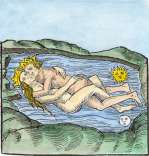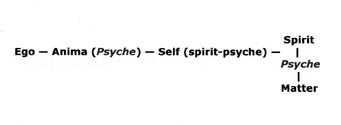4.5 The relationship between the ego, the Anima, the
Self and the anima mundi
4.5.1
The discrepancy between Carl Jung’s Anima and the anima mundi
I can clearly imagine that the reader is now rather disturbed by
all these new terms and does not exactly understand their
connections with the depth psychologist’s. Thus, I will
clarify them in this section and show how they extend Carl
Jung’s theory.
If
we briefly return to the above quote in section 4.4.3, we see
that Jung makes us believe that his Anima and thus the
alchemical queen should “not to be confused with the ‘anima’ of our
mediaeval philosophers, which was merely a philosophical anima
vegetativa, the ‘ligament’ between body and spirit.”
In section 4.4.2 we
have however seen that the Rosarium
and the other Hermetic alchemical myths tell us that exactly in
the state of the corruptio,
of the “division into indivisible parts” (visio
Arislei) in the womb of the queen, the sexual metaphor is
replaced by a vegetative myth. The “atoms” of the king
become now the seeds buried in the earth, where they die and
awake then to new life. Like this the life essence of the king, the
psyche “spirtualized” in the unio
mentalis, in the first coniunctio,
unifies
with the alchemical matter, the “earth” to form the dew.
The dew, the matter-psyche is symbolically equivalent with the
atoms of the dying king that transform into the seeds in the
earth. Like this the dead body or the “inanimate matter”
are revived. This new life is however a
vegetative life. In a modern language I call this “life
essence” the matter-psyche.
It is the soul of matter, and one of the most important
aspects of the matter-psyche is
the fact that the spirit of the Logos king stays outside it.
I guess that the
reader realizes now the discrepancy between Carl Jung’s
Neoplatonic interpretation of the unio
corporalis and the Hermetic aspect of the alchemical myth.
In the depth psychologist’s interpretation the king or
masculine god in the Heavens does not die but organizes a
wedding with the queen, the latter reduced to a spiritual
principle. We will later see that his interpretation of the unio
corporalis as a merely spiritual myth approaches this idea
very much to the Assumptio
Mariae pope Pius XII declared in the year 1950. As a logical
consequence, Carl Jung was completely fascinated with this dogma.
The Hermetic
alchemical myth means however a union of the still living
substance of the dead king or god, of the psyche or life essence
spiritualized in the unio mentalis, with matter. This union of the psyche with matter to
form the matter-psyche means in modern terms that an
energization has happened. The matter-psyche is the complement
to the spirit-psyche and the other aspect of the bipolar energy
term science does not accept,  since it is not measurable with
the help of physical tools. It is a vegetative energy and the
background of the fact that the sexual myth described in the Rosarium and in other Hermetic myths transforms into a vegetative
myth. Like this the substitution of the crude sexualism in
picture # 5 becomes possible. This vegetative continuation of
the myth is in fact – hidden behind a symbolical language –
the looked-for deeper aspect of human/animal sexuality. This
vegetative myth seems to belong to “the
procreative nature of the Whole,” which is the background of
“man’s procreative power,” mentioned by Carl Jung and
quoted in Chapter 2. As we will see, this procreative power
leads into a “new birth”,
i.e., it creates “new living matter”. Thus, the Hermetic unio corporalis is a real incarnation process, whereas the
Neoplatonic seems, if we believe in the conclusions of Wolfgang
Pauli, to be infertile.
since it is not measurable with
the help of physical tools. It is a vegetative energy and the
background of the fact that the sexual myth described in the Rosarium and in other Hermetic myths transforms into a vegetative
myth. Like this the substitution of the crude sexualism in
picture # 5 becomes possible. This vegetative continuation of
the myth is in fact – hidden behind a symbolical language –
the looked-for deeper aspect of human/animal sexuality. This
vegetative myth seems to belong to “the
procreative nature of the Whole,” which is the background of
“man’s procreative power,” mentioned by Carl Jung and
quoted in Chapter 2. As we will see, this procreative power
leads into a “new birth”,
i.e., it creates “new living matter”. Thus, the Hermetic unio corporalis is a real incarnation process, whereas the
Neoplatonic seems, if we believe in the conclusions of Wolfgang
Pauli, to be infertile.
4.5.2 Carl Jung’s exclusion of the Hermetic vegetative world soul (anima
mundi)
As I have shown in The
Return of the World Soul (Chapter 5),
it was in the year 1953 – two years before the publication of
the Mysterium
Coniunctionis – in his discussion with Wolfgang Pauli that
Carl Jung created the severe discrepancy of the two
contradicting definitions of the Neoplatonic and the Hermetic
aspect of the term psyche (see figure):

On the one hand,
for him the psyche is the Anima, the mediator between the ego
and the Self, on the other, it is the vegetative world soul, the
anima mundi, the vinculum
amoris, the ligament of love between spirit and matter. We
see now, that two years later, in the year 1955, the publication
date of the Mysterium Coniunctionis I am quoting here, by interpreting the
second phase of Dorneus’ opus in a regressive Neoplatonic way,
he even represses one part of the anima
mundi, the matter-psyche, since he is not conscious about
the necessity of the energy’s bipolarity. Thus the
matter-psyche is not a part of his God-image, of the (Logos)
Self. Like this, also the vegetative myth described in Gerardus
Dorneus’ unio corporalis
and in image # 8 of the Rosarium
is suppressed.
[proofread
GJS, 11/28/05]
part
14